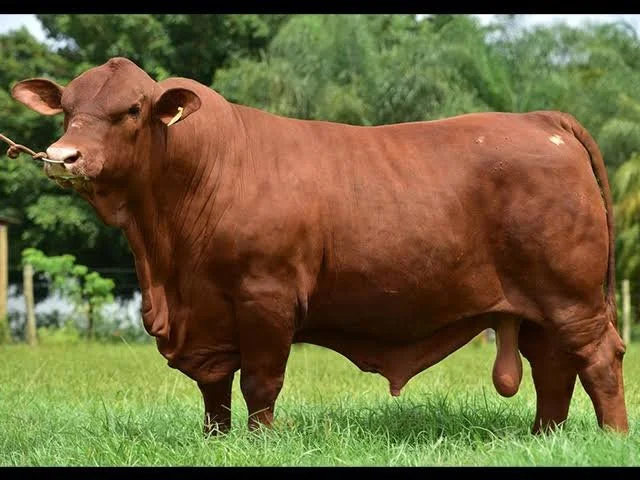Heat Genetics in Beef Cattle: Why They Matter in the South
Discover how heat genetics in beef cattle, like the resilient Senepol breed, help Southern farms extend grazing seasons, improve herd health, and produce sustainable, high-quality beef in hot climates.
Senepol bull- These cows are known for their ability to live in hot humid environments. We want to continue to raise animals that thrive in the hot south which is why we will be shifting our genetics towards heat tolerance.
As farmers and ranchers across the South strive for sustainable and efficient cattle production, one topic that continues to gain traction is heat genetics. With rising temperatures and the region's hot, humid climate, selecting cattle with superior heat tolerance is no longer optional—it's essential. One breed leading the way in this area is the Senepol, renowned for its adaptability to heat-stressed environments.
What Are Heat Genetics?
Heat genetics refer to the traits and adaptations in cattle that allow them to thrive in high-temperature conditions. These include:
Thermoregulation: Efficient cooling mechanisms like shorter, lighter coats and increased skin surface area.
Behavioral Adaptations: Grazing during cooler parts of the day and seeking shade effectively.
Feed Efficiency: The ability to maintain body condition and growth despite heat stress.
Senepol cattle, originally from the Caribbean island of St. Croix, are a standout in this category. Bred for decades to endure tropical climates, they bring heat-tolerant traits that can revolutionize beef production in the South.
Why Heat Genetics Matter in the South
Keeping cattle on grass longer is a cornerstone of sustainable beef farming, reducing the need for costly grain feeding while promoting healthier meat and soil regeneration. However, the South’s hot climate presents challenges that can limit grazing efficiency and herd health.
Here’s why heat genetics are crucial:
1. Extended Grazing Seasons
Heat-tolerant cattle, like Senepol, continue grazing during the summer months when other breeds may reduce activity. This allows producers to maximize forage use and keep feed costs low.
2. Improved Reproductive Performance
Heat stress often impacts fertility, leading to lower conception rates and longer calving intervals. Senepol cattle, with their heat-adapted genetics, maintain reproductive efficiency even in extreme temperatures.
3. Better Meat Quality
Heat stress can affect marbling and tenderness, as animals under stress often metabolize energy differently. Cattle with heat genetics stay healthier, leading to consistently high-quality beef.
4. Reduced Environmental Impact
By thriving on grass for more extended periods, heat-tolerant breeds reduce the reliance on supplemental grain, lowering the carbon footprint of beef production.
The Senepol Advantage
Senepol cattle are specifically bred for tropical climates, and their genetic traits make them an excellent choice for Southern farms:
Short, Slick Coat: Facilitates heat dissipation.
Adaptability: Performs well in diverse environments, from humid coastal regions to arid areas.
Docility: Easier to manage in high-stress conditions.
Grass Efficiency: Converts forage into weight gain effectively, even in challenging conditions.
Sustainable Farming and Heat Genetics
By incorporating heat-tolerant breeds like Senepol into their herds, Southern farmers can align with regenerative practices. These cattle not only thrive on grass for longer but also contribute to soil health by maintaining grazing pressure without over-reliance on feedlots.
Investing in the Future
As climate patterns shift, the need for heat-adapted cattle will continue to grow. By prioritizing heat genetics, farmers can ensure their herds remain productive, sustainable, and resilient—key factors for long-term success in Southern beef production.
What are your favorite southern breeds of cows? What types do you think does the best on grass?
Uppening: Using Nature With You, Not Against You: A Key to Regenerative Farming
What even is uppening??? Keep reading…..
Regenerative farming is a practice that aligns closely with the rhythms and systems of nature, aiming to not only sustain but enhance the quality of the environment. One crucial aspect of this approach is the focus on building and improving topsoil.
Topsoil is the uppermost layer of soil, rich in organic matter and microorganisms, and it's vital for healthy crop growth. In regenerative farming, the goal is to constantly enrich this layer. This is done by adding organic matter, a process colloquially known as "uppening it". Organic matter can come from various sources, including compost, manure, and plant residues, contributing to the soil's health and fertility. We feed round bales to our cows in these areas to get a double whammy of soil nutrition added.
A practical tip for regenerative farmers is to observe the land closely. Areas where bare dirt is visible are critical spots. These are the areas that desperately need attention and are ideal for dropping winter round bales. Winter round bales, typically consisting of hay or straw, decompose over time, adding organic matter back into the soil. This not only covers the bare dirt but also starts the process of building topsoil in those areas. Your cows will also gladly drop $.56 of nitrogen in manure each day in these areas.
By focusing on building topsoil, or "Uppening” , regenerative farming practices ensure that the land is not just being used for current crop production but is also being prepared for future use. This method enhances the soil's water retention, supports biodiversity, and contributes to the overall health of the ecosystem.
In essence, regenerative farming is about working with nature, rather than against it. It's a sustainable approach that benefits both the present and future, ensuring that the land remains fertile and productive for years to come.






